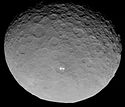Exoasteroid

An exoasteroid, exo-asteroid or extrasolar asteroid, is an asteroid located outside the Solar System. While exoasteroids and exoasteroid belts were once considered hypothetical, recent scientific studies and thorough analyses have provided evidence for their existence.[1]
Evidence
Scientists propose that the formation of exoasteroids often results from the fragmentation of exoplanets by gas giants. These exoasteroids are presumed to be the remnants of smaller celestial bodies that endured the demise of their parent exoplanet. Analogous processes are hypothesized to have occurred during the formation of our Solar System.[2][3]
History
In December 1988, American
In May 2023, the James Webb Space Telescope provided images of Fomalhaut,[7] a young star positioned 25 light-years (ly) away from Earth. Scientists analyzed these images and conducted simulations and tests on Fomalhaut's asteroid belt, proposing that it likely formed due to collisions involving larger celestial bodies.[7][clarification needed]
Another notable star hosting an asteroid belt is the white dwarf star
Detection

In 2013, astronomers discovered fragmented remnants of an exoasteroid orbiting the star
Following this discovery, scientists used the Cosmic Origins Spectrograph aboard the Hubble Space Telescope to analyze the chemical composition of the asteroid; it showed the presence of magnesium, silicon, iron, and oxygen within the asteroid's water.[9]
Proposed observational methods
Exoasteroids can be detected through various methodical processes. The
See also
References
- ^ Enking, Molly (11 May 2023). "James Webb Telescope Reveals Asteroid Belts Around Nearby Young Star - The findings suggest the star Fomalhaut may have orbiting planets hidden among its rings of debris". Smitjhsonian. Archived from the original on 31 December 2023. Retrieved 31 December 2023.
- ^ "Asteroids: Facts". nasa.gov. Retrieved 31 December 2023.
- ^ a b Gronstal, Aaron (26 January 2023). "Exo-Asteroids and Habitability around M-Dwarfs". NASA. Archived from the original on 31 December 2023. Retrieved 31 December 2023.
- ^ A low-temperature companion to a white dwarf star, E. E. Becklin & B. Zuckerman, Nature 336 (Dec. 15, 1988), pp. 656-658
- ^ Excess infrared radiation from a white dwarf - an orbiting brown dwarf? B. Zuckerman & E. E. Becklin, Nature 330, (Nov. 12, 1987), pp. 138-140
- ^ The Dust Cloud around the White Dwarf G29-38, William T. Reach, Marc J. Kuchner, Ted von Hippel, Adam Burrows, Fergal Mullally, Mukremin Kilic, and D. E. Winget, Astrophysical Journal 635, #2 (December 2005), pp. L161–L164.
- ^ a b "Webb Looks for Fomalhaut's Asteroid Belt and Finds Much More". nasa.gov. 8 May 2023. Retrieved 30 December 2023.
- ^ Letzter, Rafi (17 October 2019). "An Asteroid-Smashing Star Ground a Giant Rock to Bits and Covered Itself in the Remains". livescience.com. Retrieved 31 December 2023.
- ^ "Watery asteroid discovered in dying star points to habitable exoplanets". phys.org. 10 October 2013. Retrieved 31 December 2023.
External links
- "Alphabetical list of minor planet names". Minor Planet Center. International Astronomical Union.
- "Asteroid articles in Planetary Science Research Discoveries". Planetary Science. University of Hawaii.
- "JPL Asteroid Watch site". Jet Propulsion Laboratory.
- NASA Asteroid and Comet Watch site
- Asteroid size comparisons (video; 2:40) on YouTube









